Romanticism art ideas burst with emotion through misty mountain vistas, stormy shipwrecks, and haunting moonlit ruins. Artists placed tiny figures against nature’s fury, showing humanity’s struggle against powerful forces. Gothic castles, revolutionary scenes, and exotic Eastern marketplaces captured imagination with dramatic light and shadow. Mythological narratives and supernatural dreams added fantasy elements, while political themes showcased the era’s passion for freedom. These powerful scenes still speak to our deepest emotions today.
Key Takeaways
- Create a solitary figure silhouetted against a dramatic mountain landscape in the style of Caspar David Friedrich.
- Paint a stormy seascape with shipwreck imagery to evoke overwhelming emotion and human vulnerability.
- Depict Gothic ruins bathed in moonlight using strong contrast to create mystery and melancholy.
- Illustrate mythological narratives set in untamed forests with dramatic lighting to heighten emotional impact.
- Compose a revolutionary scene featuring heroic figures against dramatic skies to symbolize political struggle and hope.
The Sublime in Dramatic Mountain Landscapes
Wonder grips the soul when standing before a Romantic mountain scenery. These dramatic vistas capture the essence of the sublime—that overwhelming feeling of awe when faced with nature’s raw power.
Romantic artists like Caspar David Friedrich loved to paint tiny solitary figures dwarfed by massive, rugged peaks and swirling storm clouds. Talk about feeling small!
The emotional impact of these scenes isn’t accidental. Artists carefully used light and shadow to create mood, making viewers feel both terrified and thrilled at the same time. Pretty clever, right?
These paintings celebrate the individual experience of nature’s grandeur, inviting us to imagine ourselves standing on that precipice, hearts racing. Mountains weren’t just pretty backgrounds—they symbolized the human struggle against powerful forces beyond our control.
Stormy Seascapes and Shipwrecks: Nature’s Fury Unleashed
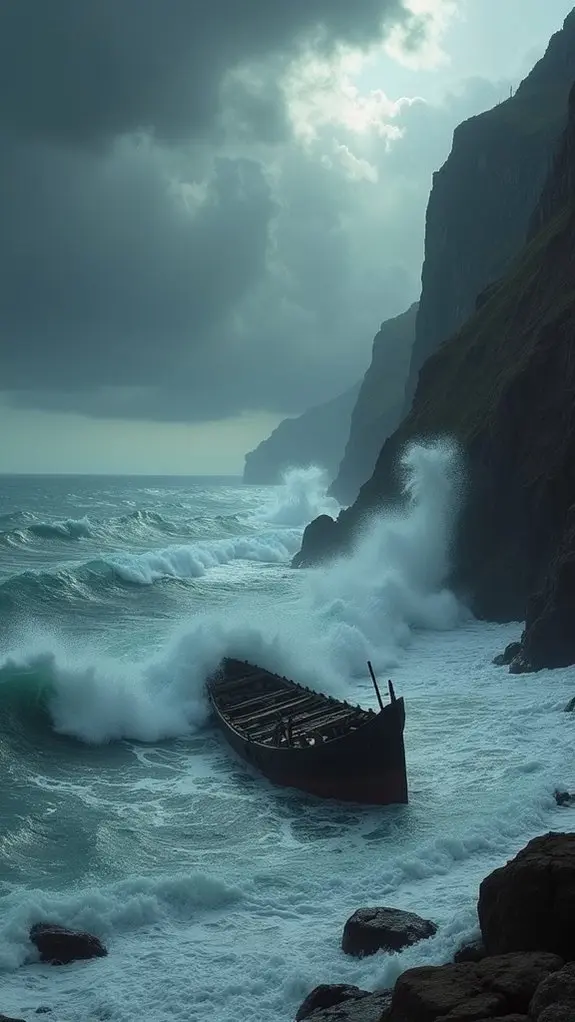
Romantic artists captured the raw terror and beauty of storms at sea, using wild brushstrokes to show massive waves crashing against helpless ships.
These dramatic seascapes, like Turner’s “The Shipwreck,” weren’t just pretty pictures—they spoke to deeper fears about how tiny humans are compared to nature’s awesome power.
Even in these watery disaster scenes, painters often included brave sailors fighting against impossible odds, turning frightening shipwrecks into moving stories of courage when facing certain doom.
Turbulent Waters Evoke Emotion
Crashing against jagged rocks and swallowing unfortunate vessels whole, the turbulent seas became a powerful canvas for Romantic artists to explore human emotion.
Painters like Turner used swirling brushstrokes and dramatic color contrasts to capture the chaos of stormy weather, inviting viewers to feel the raw power of nature. The violent waves weren’t just pretty pictures—they represented our deepest fears and struggles!
The sublime beauty of these watery scenes forced people to confront their own vulnerability. When Romantic painters showed tiny ships tossed about like toys, they were really saying, “Hey, we humans aren’t so mighty after all!”
Emotional expression reached new heights as artists transformed the terrifying reality of maritime disasters into dramatic vistas that spoke directly to the heart. Talk about turning tragedy into awesome art!
Heroism Amid Catastrophe
Amid the fury of crashing waves, heroes emerged in Romantic art, their struggles immortalized in dramatic shipwreck scenes. Artists like Géricault captured this emotional depth in “The Raft of the Medusa,” showing survivors clinging to hope while facing certain doom. What a perfect blend of terror and beauty!
Turner’s “The Shipwreck” takes viewers right into the heart of catastrophe, with sailors battling enormous waves under threatening skies. These dramatic vistas aren’t just pretty pictures—they’re packed with meaning about human courage against impossible odds.
Romanticism loved this contrast: tiny humans versus massive nature!
The sublime feeling these shipwreck scenes create—that mix of awe, fear, and wonder—helps us understand why these paintings still give us goosebumps today. Heroism shines brightest, after all, when everything seems lost.
Gothic Ruins and Melancholic Moonlit Scenes
Gothic ruins bathed in moonlight capture the essence of Romantic art‘s fascination with decay and the passage of time.
Artists painted crumbling abbeys and ancient castles at twilight, using the moon’s silvery glow to highlight broken arches and ivy-covered walls.
These haunting scenes invite viewers to feel a sweet sadness, making us wonder about the stories of those who once walked through these now-empty hallways and connecting us to something old and mysterious.
Ruins Bathed in Moonlight
When moonlight spills across ancient stones and crumbling towers, it transforms ordinary ruins into magical vistas of shadow and light. Romantic artists captured these haunting scenes to evoke profound emotional depth in viewers. The silvery glow creates dramatic atmospheres where darkness and illumination dance together, mirroring the Romanticism movement’s fascination with contrasts.
These moonlit ruins speak to themes of loss and the passing of time. Once-mighty structures, now broken and abandoned, remind us of nature’s power to reclaim what humans build.
The solitude of these settings—a lone figure contemplating a forgotten abbey or castle—invites us to reflect on our own temporary existence. Artists used these scenes as perfect backdrops for exploring the bittersweet beauty that emerges when civilization surrenders to wilderness and time.
Crumbling Abbeys at Twilight
The eerie silhouettes of crumbling abbeys against a dimming sky create some of Romanticism’s most powerful images. These Gothic ruins, with their broken arches reaching skyward like bony fingers, perfectly capture the movement’s love of melancholy and nostalgia.
Artists like Caspar David Friedrich painted these scenes to give viewers goosebumps—and boy, did they succeed!
When bathed in twilight’s fading glow, these abandoned structures take on incredible emotional depth. The play of light and shadow across ancient stonework tells stories of glory days long gone.
Romantic painters used these haunting settings to make us think about isolation and fleeting beauty. Pretty clever, right?
These artists knew that nothing says “life is short” quite like a once-magnificent abbey being slowly reclaimed by nature as the day’s light slips away.
Heroic Figures Against Wild Natural Backdrops
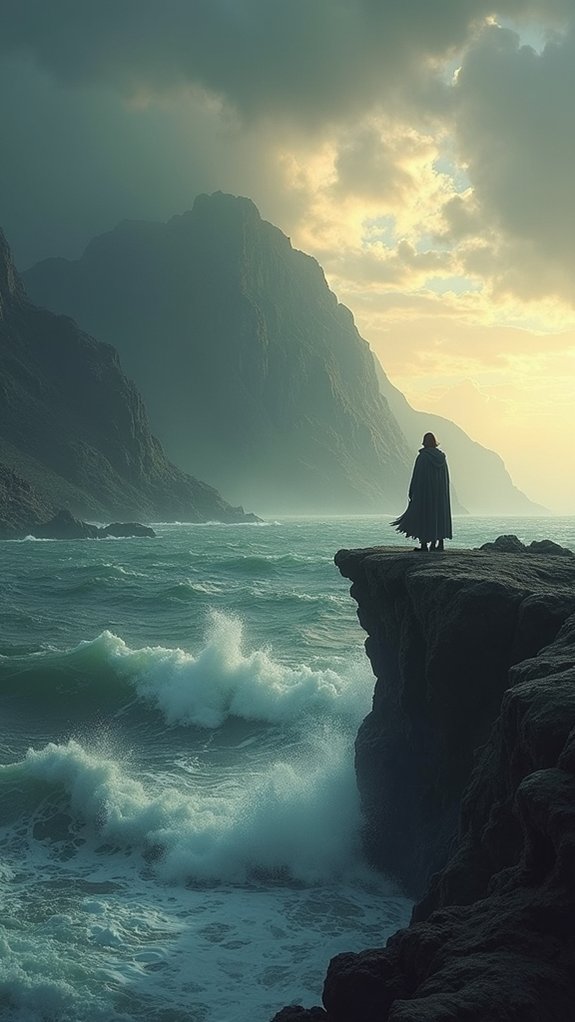
Dramatic confrontations between heroic individuals and the raw forces of nature became a hallmark of Romantic art, enchanting viewers with tales of courage and human spirit.
Artists like Delacroix and Friedrich placed warriors, rebels, and mythological figures against stormy seas and towering mountains, creating scenes that stirred powerful emotions. The dramatic contrast of light and shadow, particularly in Turner’s work, heightened tension between human determination and nature’s untamed power.
These paintings weren’t just pretty pictures—they told stories of rebellion, personal struggle, and the tiny place humans occupy in the vast natural world.
- Symbolizes humanity’s eternal struggle against overwhelming odds
- Reflects the artist’s own emotional battles through natural elements
- Celebrates individual freedom during politically oppressive times
- Creates a visual dialogue between human accomplishment and natural might
Mythological Narratives in Romantic Settings
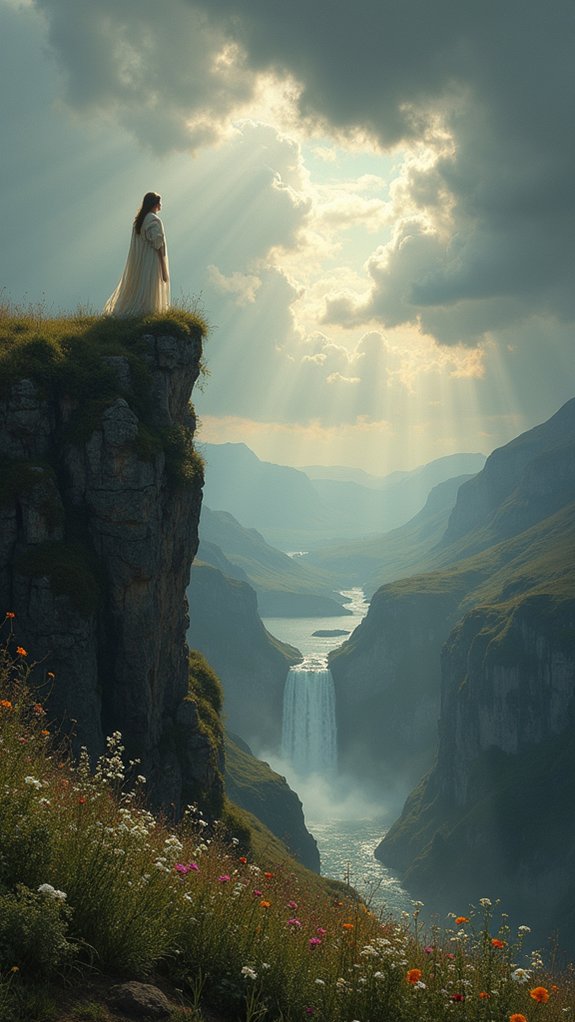
Romantic painters breathed new life into ancient myths, transforming age-old stories into vibrant, emotionally charged scenes that spoke to viewers on a personal level.
Artists like Delacroix and Waterhouse wove mythological narratives into dramatic vistas, creating works that explored the deepest human emotions through supernatural elements. The Romantic movement championed individualism, using figures from classical mythology and folklore to connect with the sublime – that overwhelming sense of awe and wonder.
These mythological settings weren’t just pretty pictures! Artists cleverly used allegory to critique society, turning ancient tales into powerful commentary on their own times.
In these paintings, stormy skies, misty mountains, and mysterious forests heightened the drama, making viewers feel like they were witnessing something magical and important happening right before their eyes.
The Solitary Wanderer: Contemplation in Nature
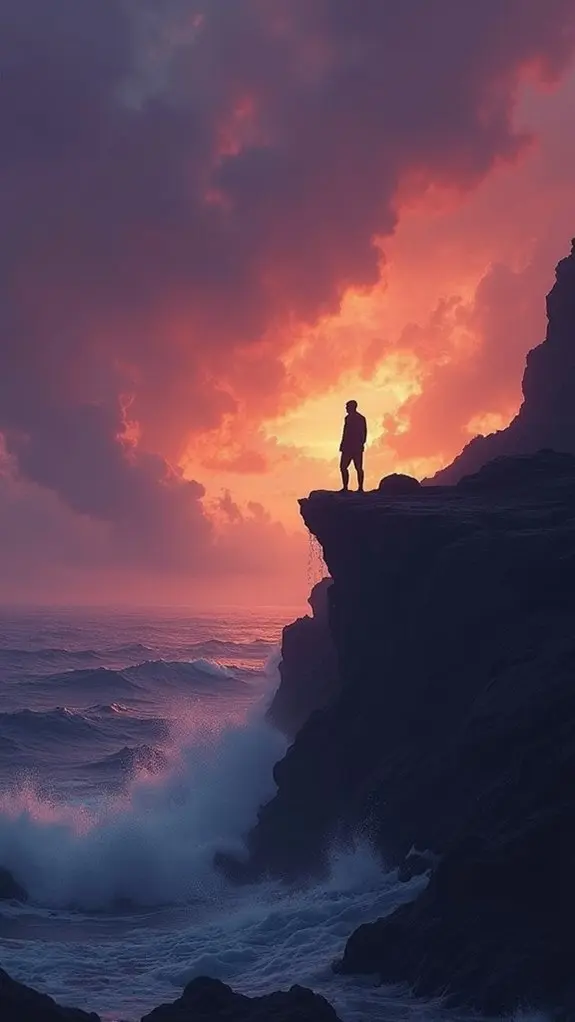
While mythological narratives transported viewers to fantastical realms, another powerful theme emerged in Romantic art that struck closer to home. The solitary wanderer motif captured the essence of human introspection amid nature’s grandeur.
In paintings like Friedrich’s “Wanderer Above the Sea of Fog,” artists depicted lone figures dwarfed by dramatic vistas, creating a visual dialogue between human existence and the sublime power of the natural world.
- The wanderer’s emotional journey invites viewers to reflect on their own place in the universe
- Atmospheric effects like fog and dramatic lighting heighten the scene’s emotional impact
- The tension between individualism and nature’s vastness creates a sense of awe
- These scenes celebrate personal experience as the true path to understanding and meaning
Exotic Eastern Landscapes and Oriental Imagery
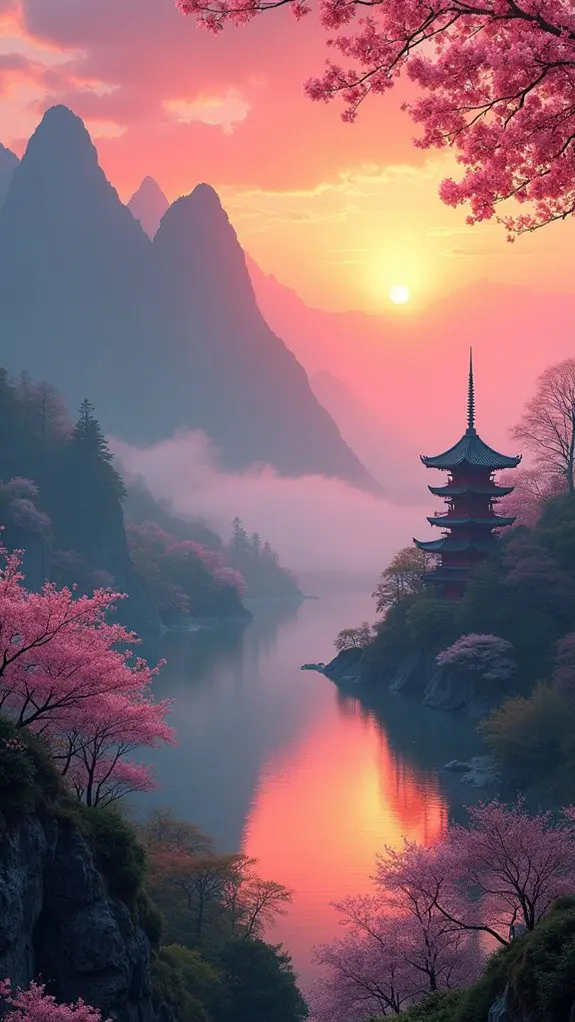
Romantic artists turned their gaze eastward, captivated by the mysterious allure of desert caravans winding through golden sands and the forbidden world of the harem.
The images of turbaned merchants, veiled women, and exotic palaces offered Western audiences a thrilling escape from the familiar, though these portrayals often reflected fantasy more than reality.
Painters like Delacroix and Ingres used rich colors and dramatic lighting to create scenes that felt both foreign and dream-like, feeding Europe’s growing fascination with the “exotic” East.
Desert Caravan Scenes
Blazing sun and endless sand dunes set the stage for one of Romanticism’s most enchanting subjects: desert caravan scenes.
Artists like Delacroix and Ingres captured the magic of travelers crossing vast, mysterious terrains, painting dramatic contrasts of light and shadow that made viewers feel the scorching heat and endless vastness of nature.
These emotive scenes weren’t just pretty pictures—they told stories about human journeys, exploration, and the thrill of discovering new places.
- Desert caravans symbolized life’s journey through unknown territories
- Vibrant textiles and cultural elements created a sense of exotic wonder
- The play of light on sand revealed the artists’ fascination with nature’s drama
- These scenes captured feelings of nostalgia and the smallness of humans against timeless vistas
Harem Mystique Portrayals
Beyond the dunes and desert caravans, Romanticism’s fascination with the East found its most alluring expression in harem mystique portrayals. Artists like Delacroix and Ingres created dazzling works dripping with Orientalism, showcasing opulent interiors where silky fabrics and gleaming treasures caught the eye.
These paintings weren’t just pretty pictures! They tapped into Western fascination with “exotic” Eastern cultures, creating an emotional connection through scenes of desire and mystery. Inspired by Lord Byron’s poetry, artists painted scenes of lounging figures in colorful rooms that made viewers’ imaginations run wild.
While beautiful, these works spread cultural stereotypes about Eastern life. The paintings said more about European fantasies than actual Eastern traditions, turning real cultures into dreamy, made-up worlds that never really existed.
Atmospheric Fog and Mist: Creating Mystery and Emotion
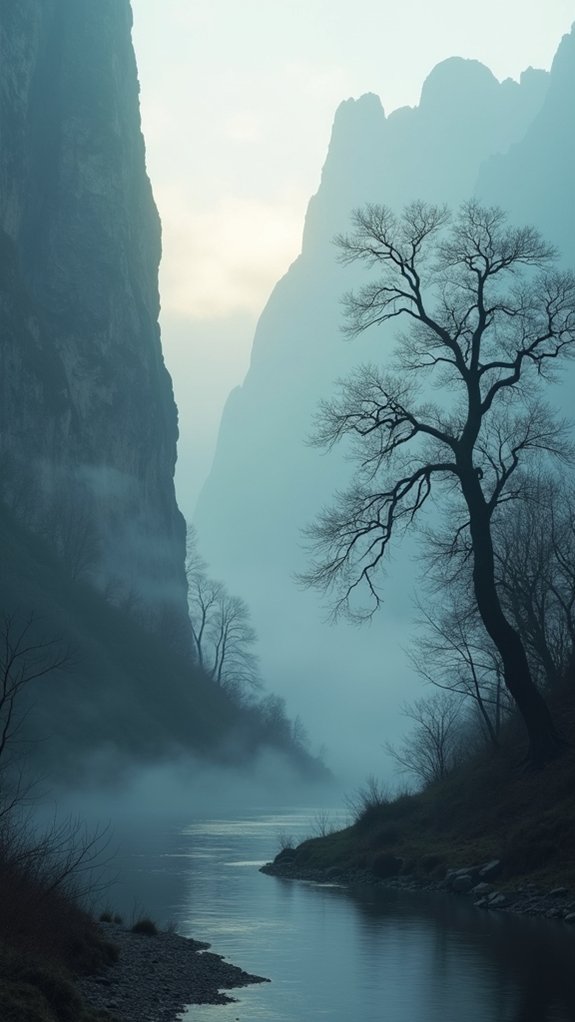
In the ethereal world of Romantic painting, fog and mist hover like ghostly veils across terrains, creating an irresistible sense of mystery.
Artists like Caspar David Friedrich used atmospheric fog to evoke emotions such as solitude and introspection in his famous work “Wanderer Above the Sea of Fog,” where a lone figure gazes into a misty abyss.
These hazy elements transform vistas into dreamlike scenes that blur the line between what’s real and what’s imagined.
- Fog acts as nature’s magician, making familiar scenes suddenly strange and new.
- Misty vistas invite viewers to fill in the blanks with their own imagination.
- The sublime nature of foggy scenes reminds us how tiny we are compared to nature.
- Artists used fog’s transformative force to create dramatic lighting effects that tug at our hearts.
Revolutionary Fervor: Political Themes in Romanticism
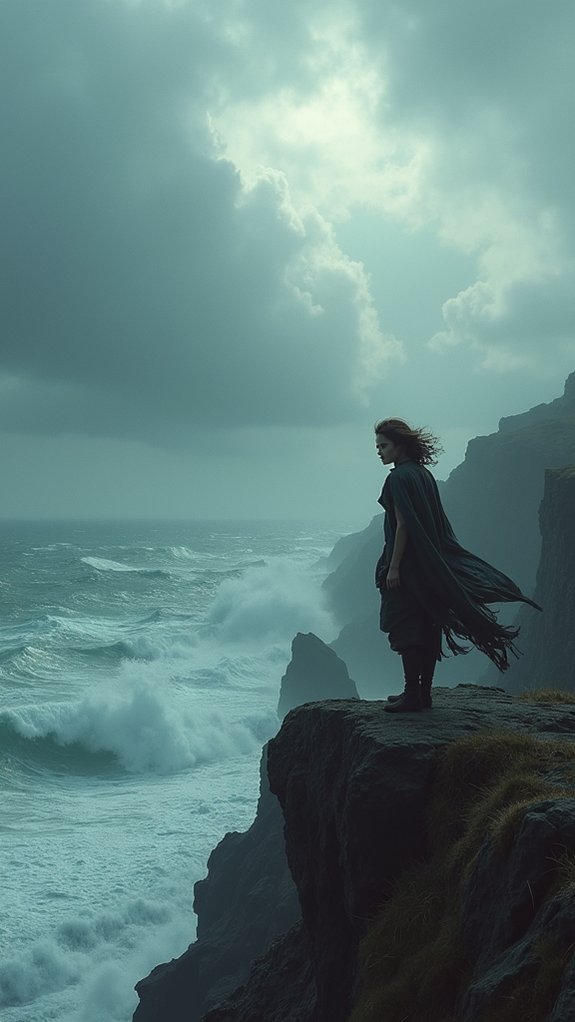
While fog created dreamlike vistas in Romantic art, revolutionary fire burned just as bright in paintings that captured the political upheavals of the era.
Artists didn’t shy away from showing the intense emotions of people fighting for freedom!
Eugène Delacroix’s “Liberty Leading the People” became an iconic image of revolutionary fervor, with its heroic female figure boldly guiding citizens through battle.
Similarly, Théodore Géricault’s “The Raft of the Medusa” revealed how art could critique government failures while celebrating the human spirit’s resilience.
These political themes weren’t just about documenting history—they expressed the deep societal tensions of the time.
Romantic painters connected personal feelings with collective struggles, turning chaotic historical moments into powerful, emotional statements that still make viewers feel like picking up a flag and marching for change!
Dreams and Nightmares: The Supernatural in Romantic Art
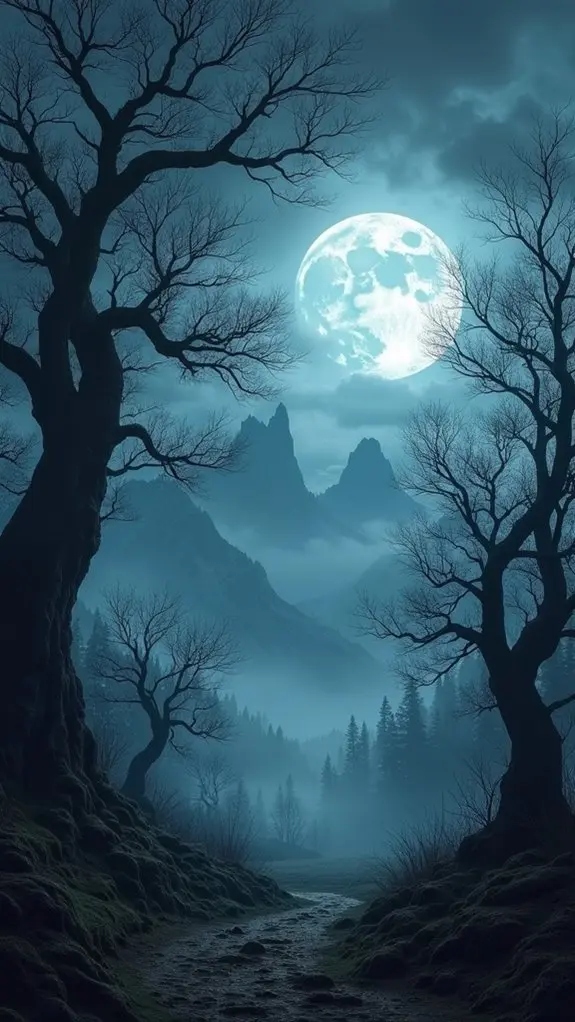
Curiosity about what lurks beyond the visible world sparked Romantic artists’ fascination with the supernatural. Artists like Henry Fuseli and Francisco Goya explored domains of nightmares and dreamlike imagery, creating works that made viewers shudder and gasp.
In “The Nightmare,” Fuseli captured the terrifying moment when sleep transforms into horror, while Goya’s disturbing “Saturn” painting revealed the darkest corners of psychological turmoil.
Gothic influences brought shadowy castles and mysterious forests into Romanticism, where dramatic vistas became stages for supernatural encounters.
- Art as a window into the unknown parts of our minds
- Nature’s power to inspire both wonder and fear
- Nightmares as expressions of personal and societal anxieties
- Emotional depth achieved through fantastical elements rather than realism
Frequently Asked Questions
What Were the Landscapes in the Romantic Period?
Romantic vistas depicted nature’s majesty with emotional depth, portraying sublime beauty through atmospheric effects. They explored wilderness while highlighting human experience, spiritual connection, and historical context within dramatic natural settings.
What Were the 3 Key Elements to Romanticism in Art?
The three key elements of Romanticism in art were: intense Emotion Expression and Personal Imagination; profound Nature Connection highlighting Sublime Beauty; and emphasis on Individual Experience through Historical Themes and Spiritual Elements.
What Type of Landscapes Were Popular Among Romantic Artists?
Romantic artists favored mystical forests, turbulent seas, majestic mountains, dramatic skies, ancient ruins, and emotional storms. These sceneries evoked powerful feelings through vibrant sunsets and occasionally serene valleys as contemplative settings.
What Are the 5 Main Characteristics of Romanticism?
Romanticism’s five main characteristics include Nature’s Influence, Emotional Expression, Individualism Focus, Imagination Over Reason, and Sublime Beauty, with artists seeking Spiritual Connection while exercising Artistic Freedom within their Historical Context.
Conclusion
Romanticism art whisks us away to dramatic worlds where mountains touch the sky and stormy seas crash against rocks. These artists didn’t just paint what they saw—they painted what they felt! Through misty forests, crumbling castles, and heroes facing nature’s fury, they showed that emotions matter just as much as facts. Their wild, colorful visions continue to inspire artists today who want to capture not just scenes, but feelings.

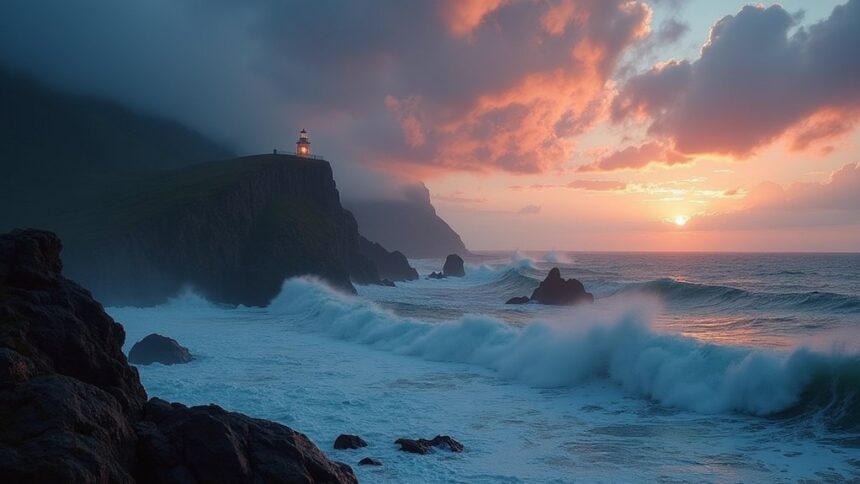
Leave a Reply